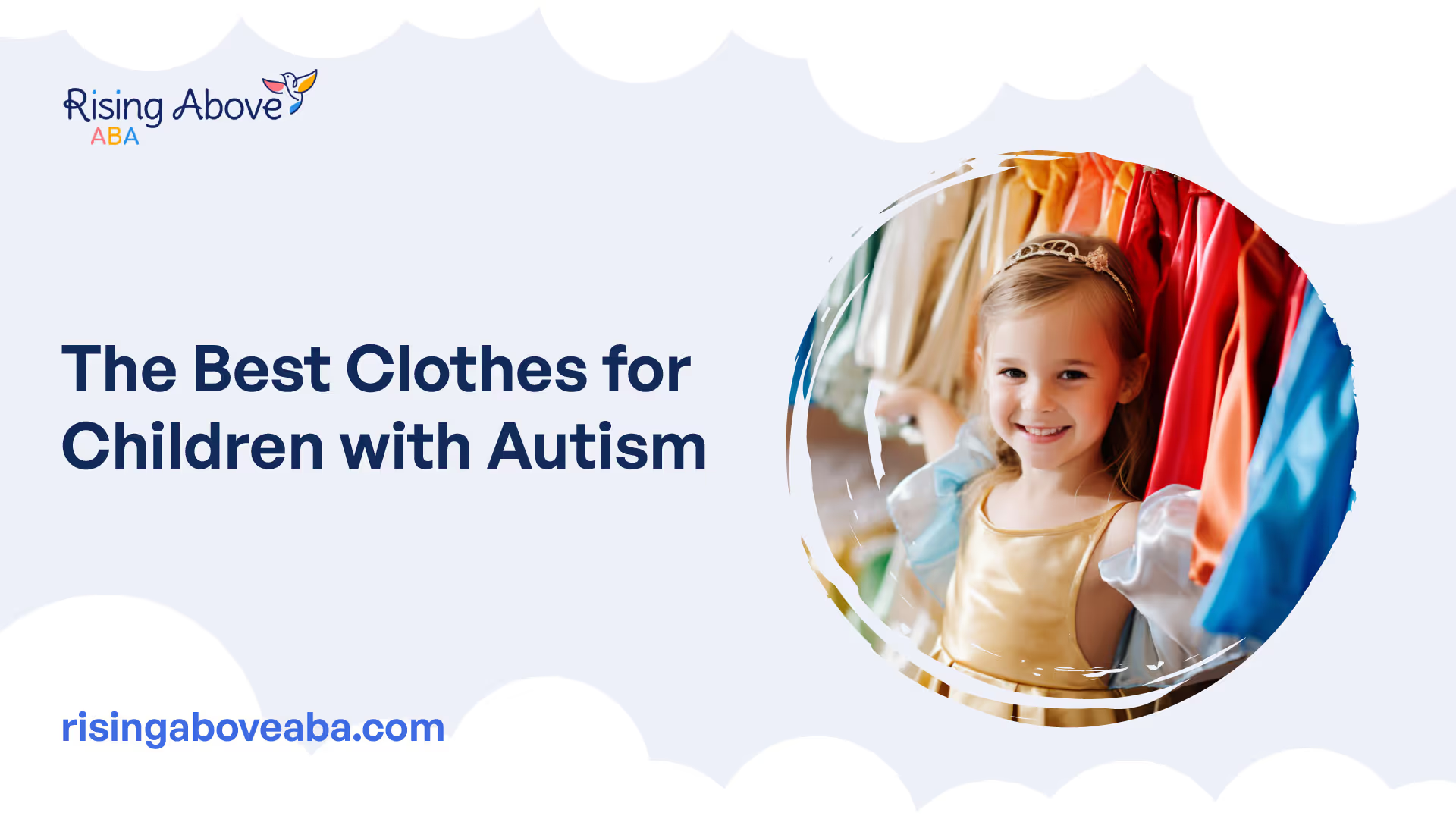The Best Clothes for Children with Autism
Discover the best clothes for children with autism, designed to unlock confidence and comfort. Find sensory-friendly solutions today!

Clothing Challenges for Children with Autism
Children with autism often face unique challenges when it comes to clothing due to their sensory sensitivities. These sensitivities can result in heightened sensitivity or aversion to certain sensory stimuli, such as textures, fabrics, seams, tags, and tight or restrictive clothing. These challenges can lead to discomfort, anxiety, and distress, making it difficult for children with autism to tolerate certain types of clothing [1]. Some specific clothing challenges faced by children with autism include:

Sensory Sensitivities and Clothing
Children with autism may experience hypersensitiveness or aversion to specific textures, fabrics, seams, tags, and tight-fitting clothing. Sensory issues with clothing can cause discomfort due to their sensory processing system, affecting their comfort with different types of materials, seams, or fits of clothing. For example, scratchy fabrics or seams can be particularly bothersome, leading to irritability and distress.
Specific Clothing Challenges
Parents of children with autism often find themselves constantly monitoring their children to prevent them from removing uncomfortable clothing. This constant vigilance is necessary to ensure the child's well-being, as clothing that is too tight or too loose can profoundly impact daily life for children on the autism spectrum. Additionally, some children with autism may develop a strong preference for wearing the same clothes repeatedly, posing a unique challenge for parents to balance their desire for consistency with promoting variety in their wardrobe choices.
Understanding these specific clothing challenges faced by children with autism is crucial in finding solutions that can help them feel more comfortable and confident in their clothing choices. By addressing their sensory sensitivities and considering their individual needs, we can unlock their confidence and support their unique journey.
Features of Autism-Friendly Clothing
When it comes to clothing for children with autism, certain features can greatly enhance comfort and reduce sensory sensitivities. Autism-friendly clothing often incorporates soft and comfortable fabrics, tagless and seamless designs, and adaptive features.
Soft and Comfortable Fabrics
Autism-friendly clothing utilizes fabrics that prioritize comfort and minimize irritation for children with autism. Soft and gentle materials such as cotton, bamboo, and modal are commonly used, as they are comfortable to wear and reduce discomfort triggered by rough or itchy fabrics. These fabrics provide a smoother and more soothing tactile experience, promoting a sense of ease and well-being.
Tagless and Seamless Designs
Tags and seams in clothing can be a significant source of discomfort for individuals with autism. To address this, autism-friendly clothing often incorporates tagless designs and seamless construction. By eliminating tags and reducing the number of seams, these garments minimize skin irritation and provide a more seamless and comfortable wearing experience. The absence of tags and seams helps to prevent sensory overload and allows children to focus on other activities without distractions.
Adaptive Features
Autism-friendly clothing may also include adaptive features that cater to the specific needs of children with autism. These features aim to simplify the dressing process and promote independence. Adaptive clothing often incorporates adjustable closures such as Velcro or snap buttons, elastic waistbands, pull-on designs, wider neck openings, and front-opening options. These adaptations make it easier for children to put on and take off their clothes, fostering a sense of autonomy and confidence.
By incorporating these features, autism-friendly clothing aims to provide comfort, accommodate sensory sensitivities, and promote the overall well-being of children with autism. The use of soft fabrics, tagless and seamless designs, and adaptive elements can make a significant difference in the comfort and daily experience of children with autism, allowing them to feel more at ease in their clothing choices.
Addressing Sensory Sensitivities
When it comes to selecting clothing for children with autism, addressing sensory sensitivities is of utmost importance. These sensitivities can cause discomfort, anxiety, and distress, making it challenging for individuals with autism to tolerate certain types of clothing. Understanding the impact of fabric choice, textures, and seams is crucial in creating a sensory-friendly wardrobe.
Importance of Fabric Choice
Individuals with autism may experience heightened sensitivity or aversion to certain sensory stimuli, including textures and fabrics. Rough or itchy fabrics can trigger discomfort and irritability. To address this, autism-friendly clothing often utilizes soft and gentle fabrics such as cotton, bamboo, and modal. These fabrics provide a comfortable wearing experience, minimizing irritation and discomfort caused by rough or itchy materials. By prioritizing fabric choice, caregivers can help children with autism feel more at ease in their clothing.
Impact of Textures and Seams
Textures and seams play a significant role in the sensory experience of clothing for individuals with autism. Some children may have hypersensitivity or aversion to certain textures, seams, and tags [1]. Autism-friendly clothing addresses these challenges by incorporating tagless designs and seamless construction. These features help prevent skin irritation caused by tags and seams, providing a smoother and more comfortable wearing experience. By eliminating rough edges or bulky seams, clothing becomes more tolerable and less likely to cause sensory discomfort.
By understanding the importance of fabric choice and the impact of textures and seams, caregivers can make informed decisions when selecting clothing for children with autism. Prioritizing sensory-friendly features helps create a wardrobe that promotes comfort and reduces sensory challenges, allowing children with autism to feel more confident and at ease in their clothing.
Strategies for Selecting Clothing
When it comes to choosing clothing for children with autism, certain strategies can help address their unique needs and sensitivities. By considering visual supports for dressing and implementing sensory strategies for comfort, caregivers can make the clothing experience more manageable and enjoyable for children on the autism spectrum.
Visual Supports for Dressing
Visual supports can be incredibly beneficial in assisting children with autism during the dressing process. These supports can include visual schedules, step-by-step visual guides, and consistent routines. By breaking down the dressing routine into smaller, more manageable steps, children can better understand and follow the process.
Establishing a visual schedule that outlines the order of tasks involved in dressing can provide a visual reference for the child, reducing anxiety and confusion. Additionally, step-by-step visual guides can help children navigate the process independently, fostering a sense of autonomy and self-confidence.
By incorporating visual supports into the dressing routine, caregivers can create a structured and predictable environment that promotes independence and reduces potential challenges.
Sensory Strategies for Comfort
Children with autism may experience sensory sensitivities that can make the clothing experience uncomfortable or overwhelming. Implementing sensory strategies can help regulate the sensory system and enhance comfort during dressing.
Deep pressure input, such as gentle and firm touch, can have a calming effect on the sensory system. Caregivers can incorporate deep pressure by providing reassuring hugs or incorporating pressure-based activities before or during the dressing process. Compression clothing, such as shirts or leggings with a snug fit, can also provide a comforting and calming sensory experience.
Alternative closures, such as hook-and-loop fasteners (Velcro) or magnetic closures, can be used on clothing items to simplify the dressing process and reduce frustration. These closures are easier to manipulate compared to traditional buttons or zippers, offering a more accessible and efficient dressing experience.
Consulting with professionals, such as occupational therapists, can provide valuable insights into sensory strategies tailored to the child's specific needs. They can offer guidance on selecting clothing materials, textures, and closures that promote comfort and accommodate tactile defensiveness or other sensory issues.
By implementing sensory strategies and considering the child's sensory preferences, caregivers can create a dressing experience that minimizes sensory discomfort and promotes overall comfort.
Understanding the unique challenges and needs of children with autism can guide caregivers in selecting clothing that fosters independence, comfort, and confidence. By incorporating visual supports and sensory strategies into the dressing routine, caregivers can create an environment that supports the well-being and sensory needs of children on the autism spectrum.
Autism Clothing Solutions
To address the unique clothing challenges faced by children with autism, there are specific solutions that can greatly enhance their comfort and overall well-being. Autism-friendly clothing incorporates various features designed to accommodate sensory sensitivities and promote independence in dressing.
Soft Fabrics and Seamless Options
One of the key considerations when selecting clothing for children with autism is the fabric choice. Soft and comfortable fabrics play a crucial role in ensuring a pleasant sensory experience. Fabrics like cotton or bamboo that are soft to the touch and gentle on the skin can help minimize tactile discomfort and sensory sensitivities. These fabrics provide a smoother and more soothing tactile sensation, reducing the chances of triggering discomfort or sensory overload.
In addition to fabric choice, seamless clothing options are often favored for children with autism. The absence of seams helps prevent skin irritation caused by tags and seams, providing a smoother and more comfortable wearing experience. Tagless designs eliminate the potential for discomfort or distraction caused by tags rubbing against the skin. Seamless construction also contributes to a seamless sensory experience, reducing potential sources of irritation and promoting greater comfort.
Adaptive Closures for Ease
Autism-friendly clothing often incorporates adaptive features to simplify the dressing process and promote independence. These features aim to address the fine motor challenges that some children with autism may face. Adaptive closures, such as Velcro or snap buttons, can replace traditional buttons or zippers, making it easier for children to dress and undress themselves. Adjustable closures provide flexibility and accommodate different body shapes and sizes, ensuring a comfortable fit.
Other adaptive features may include elastic waistbands, pull-on designs, wider neck openings, and front-opening options. Elastic waistbands eliminate the need for complex fastenings, allowing for easy and comfortable dressing. Pull-on designs eliminate the need for buttons or zippers altogether, simplifying the dressing routine. Wider neck openings make it easier to put on and take off clothing, while front-opening options provide convenience and accessibility for individuals who may have limited mobility or dexterity.
By incorporating these adaptive features, autism-friendly clothing empowers children with autism to develop their independence and confidence in dressing. These features not only simplify the dressing process but also contribute to a more positive sensory experience, reducing potential triggers for discomfort or anxiety.
Understanding the specific clothing needs of children with autism and providing them with appropriate clothing solutions can greatly enhance their comfort and promote a sense of well-being. By prioritizing soft fabrics, seamless designs, and adaptive closures, caregivers and parents can help create a more sensory-friendly and comfortable wardrobe for children with autism.
Sensory Processing in Autism
Understanding sensory processing in autism is crucial when considering clothing choices for children on the spectrum. Sensory processing disorder, often seen in individuals with autism, refers to heightened or diminished sensitivity to sensory input. This can result in adverse reactions to certain fabrics, such as scratchy labels, tight clothing, and socks with hems, which may lead to meltdowns or discomfort in children with autism.
Sensory Defensiveness and ASD
Sensory defensiveness, a specific sensory modality in autism spectrum disorder (ASD), has been relatively less examined compared to other sensory issues. Recent studies have shed light on the impact of fabrics on the well-being of individuals with autism, highlighting the importance of understanding tactile defensiveness in creating autism-friendly approaches with appropriate fabric choices.
Children with sensory defensiveness may exhibit aversive reactions to certain fabrics due to their hypersensitivity to tactile stimuli. The touch and feel of fabrics can be overwhelming, leading to discomfort and distress. Recognizing and addressing these sensory sensitivities is crucial in providing clothing options that promote comfort and well-being.
Role of Sensory Integration Therapy
Sensory integration therapy plays a vital role in the treatment of autism spectrum disorder. It focuses on addressing sensory processing deficits and aims to improve the individual's ability to process and respond to sensory information effectively. A study on sensory processing deficits in autism spectrum disorder found a significant negative correlation between sensory processing disorder and core autism symptoms, such as communication and social interaction deficits. This underscores the importance of sensory integration therapy as an integral component of autism treatment.
Sensory integration therapy can help children with autism develop strategies to regulate their sensory experiences, including sensitivities to fabrics. By working with occupational therapists trained in sensory integration, children can gradually desensitize themselves to certain tactile stimuli, leading to increased tolerance and acceptance of different fabric textures.
Understanding the impact of sensory processing in autism and the significance of sensory integration therapy can guide the selection of clothing that accommodates the specific sensory needs of children with autism. By choosing fabrics that minimize sensory discomfort and employing strategies that promote sensory regulation, we can provide children with autism clothing options that enhance their comfort, confidence, and overall well-being.
References

Compassion. Communication. Positivity. Professionalism
Give us a call at 888.572.7473 or reach out to our team online to get started—we're looking forward to partnering with your family.
Latest articles






Reach Out to Rising Above ABA

Most commercial insurance accepted
Contact us for any questions regarding coverage or plans – we’ll be happy to provide you with the clear guidance as to your best options.


